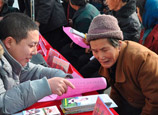
HOUSTON, Oct. 26 (Xinhua) -- An exhibition was inaugurated Friday at the Houston Museum of Natural Science to demystify the ancient Maya culture and debunk the myth that the Mayans predicted that "2012 will be the last year for human beings."
The exhibit, Maya 2012 Prophecy Becomes History, gives visitors an overview of the about 3,000 years of the Maya culture and explain to them why the "world end" claim is not true, said Dirk Van Tuerenhout, curator of anthropology at the Houston Museum of Natural Science.
The main focus of the exhibit "is the calendar, the time keeping, because everybody wants to know what will happen on December 21 this year," said Tuerenhout.
The Mayans had many calendars and "one of them is coming to an end on the day of December 21, 2012, but it will start all over again," said Tuerenhout, stressing that none of the Mayan calendars tell people that there is an end of the world.
The Mayan calendars have a different count each. The "ritual" cycle was 260 days long, the time between the planting of the corn, or possibly, the time from human conception to birth, experts say. They also had a 365-day calendar, similar to our own, and the two met once every 52 years, which also matched the average life expectancy of a person living at that time.
A Mayan calendar with a "long count" begins with Maya creation and ends three days before Christmas Eve, that is the focus of the end-of-the world beliefs. This count is broken up into 13, 400- year segments, or baktuns. The last one ends on December 21, 2012, and the ancient Maya believed that on December 22 they would start counting again from zero.
The day of December 21, 2012 only marks the end of the big cycle of one of the Mayan calendars and after that, there should be the beginning of a new cycle, said Tuerenhout.
About 150 pieces were on display at the exhibit that starts with the pre-Hispanic era from 1500 BCE to 1500 CE, touches on the colonial period that existed until the 1800s and ends with the modern Maya of the past two centuries, the point being that Maya people are still around.
Exhibits included ceramic, jade and gold carvings, black-and- white rubbings of jungle monuments, photographs, reconstruction of buildings, and video and computer-generated images that explain the Mayan calendars.
Ancient Mayans were believed to be masters of time, keepers of good calendars.














 Beijing-Zhengzhou high-speed railway to start service on Dec. 26
Beijing-Zhengzhou high-speed railway to start service on Dec. 26


![]()
